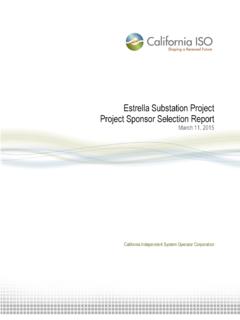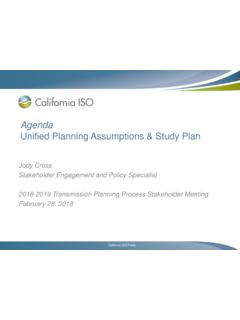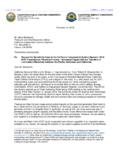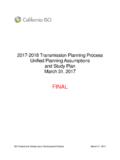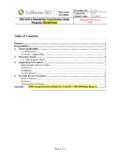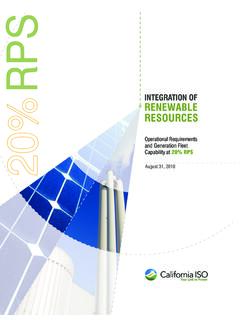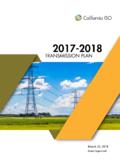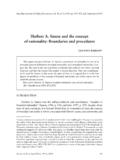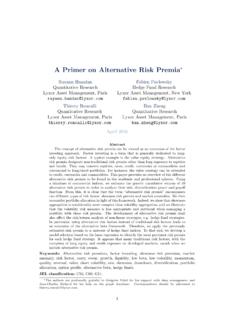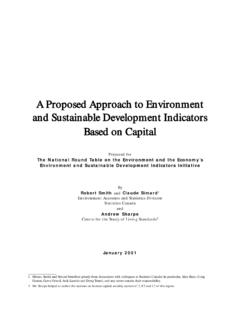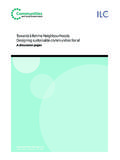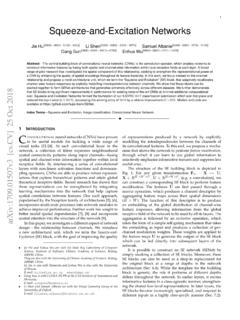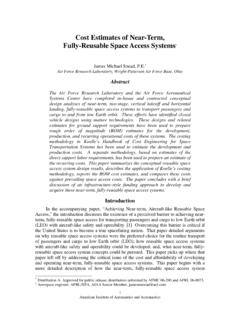Transcription of Storage as a Transmission Asset - caiso.com
1 Storage as a Transmission Asset : Enabling Transmission connected Storage assets providing regulated cost-of-service-based Transmission service to also access other market revenue streams Issue Paper March 30 , 2018 California ISO Issue Paper ISO/M& 2 March 30, 2018 Table of Contents 1. Executive Summary .. 3 2. Stakeholder Comments on Issue Paper .. 4 3. Stakeholder Engagement Plan .. 4 4. Introduction and background .. 5 5. Scope and Identified Issues .. 8 Scope of policy examination .. 8 Cost recovery mechanism .. 9 Market participation rules and limitations ..13 Allocation to high or low voltage ..14 6. Next Steps ..14 California ISO Issue Paper ISO/M& 3 March 30, 2018 1. Executive Summary In light of advances in incorporating Storage and other preferred resources into the Transmission planning process, the California Independent System Operator Corporation ( ISO ) is reexamining its consideration of Storage resources in the Transmission Planning Process ( TPP ).
2 Developments at both the state and federal levels are driving a more comprehensive and integrated view of Storage as a resource that can provide both Transmission and market services. In the past, the ISO has considered numerous proposals for Storage devices to provide cost-of-service based Transmission services in the TPPs, and recently the ISO approved two such proposals. Enabling Storage facilities to provide Transmission service under a cost-of-service framework, while also participating in the energy and ancillary services markets, can generate additional ratepayer benefits relative to a solely regulated Asset . However, this type of hybrid resource introduces unique challenges that must be carefully considered in the policy development process. The overarching objective of this initiative is to determine a pathway for Transmission connected Storage assets providing a regulated cost-of-service Transmission service to also provide market-based services and access market revenues, thus lowering costs and providing greater flexibility for the benefit of ratepayers.
3 This may include options such as providing additional market-based services, with the resulting market-based revenues ultimately reducing the burden on rate-paying consumers. In light of this general consideration, the scope of this initiative will focus on (1) Transmission -connected Storage resources only, and (2) Storage resources identified by the ISO as the more cost effective or efficient resources needed to provide reliability-based Transmission services. This issue paper explores the framework and requirements - and allowable mechanisms - for those resources to also access market revenues by providing market-type services that do not conflict with the fundamental reliability purpose for which the ISO selected the specific solution in the TPP. The ISO identifies for discussion the following alternative mechanisms for a Storage resource serving as Transmission to meet an identified reliability need : 1) As an Asset in a Participating Transmission Owner s ( PTO ) Transmission Access Charge ( TAC ) rate base, or 2) Contractual provision of cost-based Transmission service without becoming a PTO.
4 Each of these mechanisms has two potential options that the ISO will explore in this initiative. These options include a wholly in rate base option that guarantees cost recovery of the resource, and market revenues earned by the resource would reduce the costs recovered through the TAC, and a partially in rate base option that would guarantee a portion of the resource s costs, with the owner at risk - both upside and downside risk - of recovering its remaining costs (and return) from market revenues. The ISO must establish the necessary market participation rules to ensure that all of the market participation policy objectives identified by the Federal Energy Commission ( FERC ) are addressed. Additionally, the ISO will consider rules that ensure the resource is available to California ISO Issue Paper ISO/M& 4 March 30, 2018 address ISO reliability as needed.
5 Specifically, the ISO will assess the need for notification time-lines, capability duration needs, and energy and/or cycle limitations necessary to maintain the resource s life-cycle. 2. Stakeholder Comments on Issue Paper Stakeholder comments on this issue paper are due April 20 and should focus on the following: 1) proposed scope; 2) Feedback regarding identified issues; and 3) Specific issues not already discussed in this issue paper that stakeholders believe should be included in the scope of the initiative. Please provide support for new issues that should be included in the scope. The ISO will address stakeholder comments as part of the straw proposal that is scheduled to be posted on May 14. 3. Stakeholder Engagement Plan Date Milestone Mar 30 Issue paper Apr 6 Stakeholder call on issue paper Apr 20 Stakeholder comments on issue paper due May 14 Straw proposal May 22 Hold stakeholder meeting on Straw proposal Jun 5 Stakeholder comments on Straw proposal due Jun 21 Working group meeting Jul 9 Stakeholder comments on working group meeting due Aug 14 Revised straw proposal Aug 21 Hold stakeholder meeting on revised straw proposal Sep 4 Stakeholder comments on revised straw proposal due Sep 24 Draft final proposal Oct 4 Hold stakeholder meeting on draft final proposal Oct 15 Stakeholder comments due Nov 14-15 Present proposal to ISO Board California ISO Issue Paper ISO/M& 5 March 30, 2018 4.
6 Introduction and background In past Transmission Planning Processes, the ISO has considered numerous proposals for Storage devices to provide cost-of-service based Transmission services, and the ISO recently approved two such proposals. Having Storage facilities that both provide Transmission service under a cost of service framework and participate in the various energy markets introduces unique challenges that must be carefully considered in the policy development process. These challenges and the ISO s interpretation of previous FERC rulings dissuaded the ISO from pursuing the concept further. However, FERC opened the door to revisit this issue by issuing its Policy Statement in Docket No, PL17-2-000 regarding the utilization of electric Storage resources for multiple services when receiving cost-based rate Also in 2005, the Nevada Hydro Company filed a request for rate incentives with FERC for its proposed Lake Elsinore Advanced Pump Storage ( LEAPS ) In its filing, Nevada Hydro proposed that LEAPS should be treated as a Transmission facility under the ISO s operational control.
7 According to Nevada Hydro, the ISO would serve its ancillary services needs consistently from LEAPS, and Nevada Hydro would consistently bid LEAPS stored energy into the market at a price of $0. Nevada Hydro asserted that it had carefully crafted its proposal to avoid market distortions. Specifically, Nevada Hydro proposed to always bid its stored energy at $0 to avoid market distortions. The ISO was nevertheless concerned that its independence could be comprised because it would have to decide (in all instances) when LEAPS would operate, how much energy it would produce and when it would operate the pumps to store water for future In a 2008 order, FERC denied Nevada Hydro s request. FERC found that the purpose of CAISO s Transmission access charge is to recover the costs of Transmission facilities under the control of CAISO, not to recover the costs of bundled services. 4 FERC also shared the ISO s concern that ISO control of a generator participating in the ISO markets would compromise the ISO s independence.
8 Further, FERC found that allowing LEAPS to receive a guaranteed revenue stream through CAISO s TAC would create an undue preference for LEAPS compared to these other similarly situated pumped hydro generators. 5 In 2009, Western Grid Development filed a petition for declaratory order with FERC to request a finding that its proposed sodium-sulfur-based energy Storage projects were wholesale Transmission facilities eligible for cost-based Western Grid proposed that its Storage projects would only exist to provide voltage support and thermal overload protection, and that 1 Utilization of electric Storage Resources for Multiple Services When Receiving Cost-Based Recovery, 158 FERC 61,051 (2017) ( Policy Statement ). 2 The Nev. Hydro Co. Inc., 122 FERC 61,272 (2008). 3 See Utilization of Electric Storage Resources for Multiple Services When Receiving Cost-Based Rate Recovery, 82 9343 at P 3 (Feb.)
9 6, 2017). 4 Id. 5 Id. 6 Western Grid Dev., LLC, 130 FERC 61,056 (Western Grid), reh'g denied, 133 FERC 61,029 (2010). California ISO Issue Paper ISO/M& 6 March 30, 2018 they could solve existing reliability problems at a lower cost than traditional Transmission Western Grid argued that unlike with LEAPS it would manage the charging of its devices to allow the ISO to maintain independence. Western Grid also notified the Commission that it would not arbitrage wholesale energy market prices, and would credit any market revenues it received from charging and discharging back toward its Transmission revenue requirement. In a 2010 order, FERC found that Western Grid s proposal had resolved the issues presented in Nevada Hydro, and that Western Grid s project should be eligible for cost-based recovery. FERC found that Western Grid would operate its devices as Transmission facilities only, and therefore should recover costs like a Transmission facility.
10 FERC also noted that its order was only limited to the issue of eligibility for cost-based treatment, but that: the Projects will be subject to review and approval by the CAISO in its Transmission planning process. Pursuant to CAISO Tariff section , the CAISO will not approve the Projects if a superior alternative project is proposed or if the Projects do not pass a cost-benefit analysis. Thus, if the CAISO approves the Projects, they would be paid for by ratepayers because the CAISO had found that they were the most efficient solution Ultimately, the ISO never found the Western Grid projects to be needed in the ISO s TPP. Since the Western Grid decision, the ISO has studied a number of potential energy Storage projects as reliability solutions, ranging from Transmission Asset models to local resources participating in There remained uncertainty between the generator-oriented approach rejected in Nevada Hydro and the Transmission -only approach approved in Western Grid.

